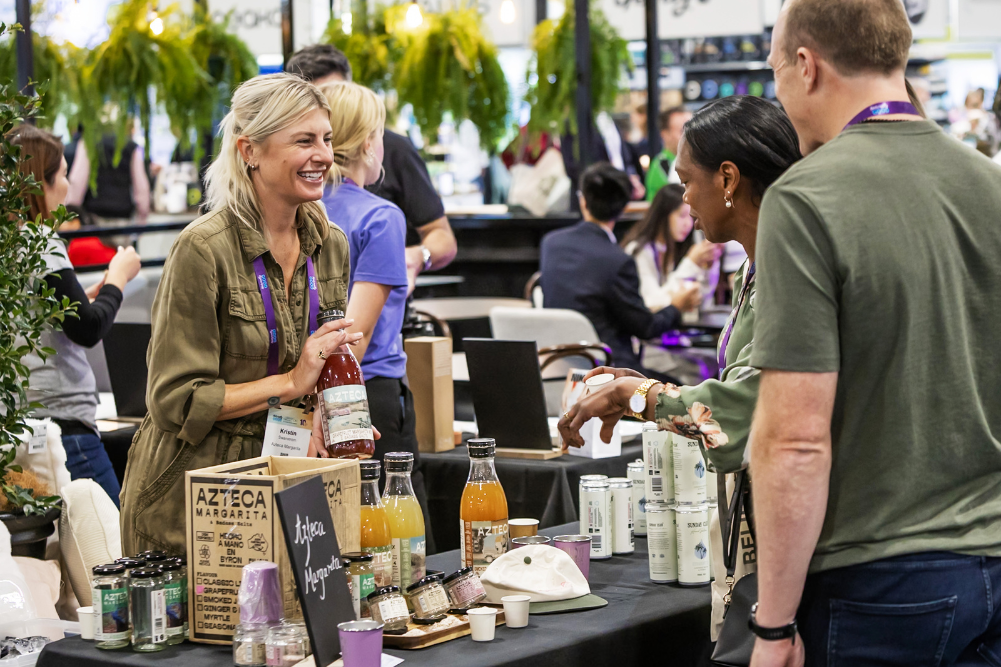The fuss about farmers markets
As I write, stone fruit is in season. There are still some apricots, peaches, nectarines and plums available to buy and figs will be around in a week or two, according to a grower from the Adelaide Hills. Salty, sweet tomatoes are everywhere and very cheap — it must be summer in an Australian market.
But this market has a more conversational tone. Customers enquire about what is on offer and the person behind the counter is more than happy to share because he knows. He was there — he grew it! This is a farmers’ market, in it’s green and sustainable glory. I ask about the huge cos lettuce for $2. “I picked it this morning,†the fellow says as he admires the heavy, football-sized head.
In a country where almost 80 per cent of all food sales pass through the cash registers of two big supermarket chains, farmers’ markets are defiantly springing up all over the country — and city — offering a delightful array of fresh produce and an opportunity for consumers to get a bit closer to its source. These markets are the feel-good face of the local food movement. Enjoying lively flavours with confidence in food’s origin and production, and the pleasure of cooking and sharing it, is compelling people to step back from corporate-dominated fast-food culture where convenience is king and taste, health and sustainability are optional.
Food is at the centre of the rituals that bind us together and the most intimate way in which we relate to the earth. Eating locally is natural for humans. Anyone who has ever bitten into a peach still warm from the tree or grown their own tomatoes knows this well: it’s about connecting with the seasons, the earth and millennia of human tradition and endeavour.
When so much of the food we buy in supermarkets is just a floury shadow of the real thing, farmers’ markets, community gardens, backyard vegie patches, local food exchanges and community-supported agriculture (CSAs) are all ways people are getting back in touch with real food and the rhythm of the seasons.
In the second half of last century, globalisation, brought about by “free†trade and cheap fossil fuels, saw the expansion of international food markets. Supermarkets have been able to defy the limits of local climate and season, offering oranges from California, kiwifruit from Italy, bananas from the Philippines and garlic from China, so that there’s no sense of what’s really in season locally.
In just a couple of generations, our palates have broadened as borders have opened and people have migrated around the world, taking their food traditions with them, older cultures fusing with new. I doubt garlic was even on my nanna’s shopping list, let alone garlic that has been grown in China!
This is a tasty benefit of globalisation and has meant that the countries of the minority, industrialised world have access to a diverse array of fruit and vegetables, regardless of the unique limits of their home environments. Britain has become a very large importer of fresh food, to the extent that half of the vegetables and over 95 per cent of fruit eaten in the UK come from outside the country.
Yet, as awareness has grown about the impact of industrial societies, our oil-dependent global food system has come under an increasingly critical gaze. Agriculture is not only affected by climate change, but is a major contributor to it. Concerns about the environmental impact of “food miles†(the distance our food travels from farm to fork) have catalysed a debate on the appropriateness of globe-trotting groceries. Shops now display labels indicating what country produce is from.
With a more temperate climate, Australia has historically produced much of its own fresh food, but in the past four years the amount of fresh food Australia imports has increased by 26 per cent and, as climate change begins to bite into the productivity of Australia’s key agricultural regions, many commentators claim this may increase.
A recent preliminary study into Australian food miles conducted by Melbourne’s Centre for Education and Research in Environmental Strategies (CERES) examined a typical Grocery basket and found that the items it contained may have travelled up to 21,073 kilometres in Australia. This distance is comparable to the circumference of the Australian mainland. The study indicated that these figures were conservative and acknowledged the limits of food miles as an indicator of sustainability. Rather, it’s important to consider food miles as an entry point into a broader discussion about the sustainability of food.
Transportation is just one aspect of the global food system. For example, while beef is one of the “least travelled†items of the report, a Victorian Water Trust report found that red meat and dairy production accounts for more than one-quarter of Victoria’s total water use (ECOS, 2008), highlighting that beef, for example, carries a significant environmental impact.
It’s not just transport that’s consuming fossil fuels in the industrial food system. The inputs such as fertilisers and pesticides that are required to produce the broad-acre monocultures that are the staple of Big Agriculture are also heavily dependent on oil. In fact, as one US National Research Council study found when comparing the efficiency of industrial-scale farms compared with smaller farms, smaller farms won out in terms of efficiency due to their significantly smaller use of “synthetic chemical pesticides, fertilisers and antibiotics per unit of production than conventional farmsâ€. The impact of these synthetic inputs doesn’t stop with their oil dependence; they’re also key contributors to soil degradation and water pollution.
The soy or corn required to feed livestock raised in confined animal feeding operations (CAFOs), or feedlots, for meat, milk and eggs needs to be fertilised, irrigated, processed, packaged and transported to the highly centralised CAFOs. And that’s before the cow or chicken has eaten it! Grass-fed cattle emit an estimated 40 per cent fewer greenhouse gases due to lower emissions from feed production and better digestibility of the grass, and many studies indicate reduction in meat and dairy consumption is one of the best ways to reduce our food-related carbon footprint.
In 2008, the spectre of a global food crisis became all too real. The global price of wheat rose by over 70 per cent and rice rose by 16 per cent, triggering food riots across the world and inciting analysts to declare the end of cheap food. While arguments for eating locally as a response to environmental concerns about carbon emissions are compelling, communities all over the world are finding that a re-localisation of their food systems can reinvigorate local economies and build stronger, more resilient communities. Buying from local producers keeps profits in the local community rather than sending them off to the distant head offices of supermarket chains. Despite the economic downturn, farmers’ markets are one style of business that continues to expand.
“The recession climate is adding a new growth spurt and new starts, especially in Queensland, which has always lagged behind other states,†says Jane Adams, chair of the Australian Farmers’ Market Association. Zannie Flanagan, one of the founders of the Adelaide Showgrounds Farmers’ Market, which has been growing since its inception in October 2006, concurs: “People want to make sure their dollar is going to go where it is needed most, supporting the people in their communities, rather than distant corporations.â€
Eating locally is a crucial means of taking back some control over where and how our food is produced rather than relying on the long and anonymous supply chains of corporations and global food markets, and also supports green and sustainable living. One of the most immediate ways of eating locally is, of course, to grow your own food. Urban permaculture gardens have famously contributed to making Cuba one of the most self-sufficient and sustainable countries in food. Most of green Havana’s food now comes from within the city limits, a situation that has arisen out of necessity as much as innovation.
Following the collapse of the Soviet Union, Cuba’s main trading partner, the island nation was no longer able to access the fuel and fertilisers on which it had been dependent. Despite continuing trade embargoes enforced by its nearest neighbour, the United States, Cuba has held off hunger through a concerted shift to organic, urban agriculture.
Australia, too, has a long heritage of sustainable urban food production, from the traditional backyard vegie patch to city farms and community gardens. “Urban agriculture must be part of our future food supply. With peak oil just around the corner, there is no alternative,†says Ben Neil, CEO of Cultivating Community, an umbrella organisation for community gardens in Melbourne. And he has seen rising demand for it.
“In two years, there has been a 30 per cent increase in community gardens in Melbourne alone. Councils are writing policy supporting their development and things like community food swaps are on the rise. Finally, local government is catching up — now we have to wait for state and federal governments to catch up!â€
Following the increasingly popular model of the Urban Orchard homegrown fruit and vegetable exchange, community members in Adelaide’s inner western suburb of Croydon recently set up such a swap in a local park. Participant Genevieve Harris commented, “We have only been going for three weeks, but already after beginning with only three of us there are now 20 of us. And half of those are people who use the [local Adelaide Showgrounds’] Farmers’ Market as well. For them, it is a fabulous way of extending the idea of eating locally.â€
The concept of eating closer to home supports a more green, sustainable and healthier food system that is independent of international money markets. The global food trade is also putting the responsibility for our food supply in the hands of an ever-shrinking group of huge corporations that are driven by profit rather than concerns for community wellbeing and environmental or human health.
The figures on who controls the global food supply are arresting. Globally, two corporation, Cargill and Archer Daniels Midland, control 70–80 per cent of the world’s grain trade. In Australia, the top 10 per cent of farms in terms of size are responsible for 60 per cent of total agricultural output and this share is growing. Australia has the highest concentration of food retailers with Woolworths and Coles sharing about 80 per cent of food sales in this country. That kind of power allows them to put far too much price pressure on growers, who need to sell to the biggest buyers.
This pattern is the same in most industrialised countries, with small, diverse local producers and retailers being pushed out or pressured on price by big, centralised corporate operations. This corporatisation of the food chain demands long and complex distribution and supply chain arrangements that are ultimately inefficient but match the industrial scale of broad-acre agriculture.
Characteristic of the corporatisation of the global food chain is the demand for broad-scale farming of single crop varieties, or monocultures. Through the rise of monocultures, a massive amount of the genetic diversity of our food, a diversity cultivated by farmers over generations as they meticulously developed locally adapted varieties through natural breeding processes, has been lost. Between 1903 and 1983, 80 per cent of tomato varieties were lost; more than 90 per cent of lettuces and in excess of 95 per cent of sweet corn varieties disappeared and 86 per cent (more than 6000 varieties) of apples vanished.
This reduction has largely been profit-driven, with traditional varieties, bred for their resilience, their local adoption, their taste or nutritional value, being replaced by varieties cultivated for high yields, uniform appearance and, crucially, an ability to withstand long-distance travel as a requirement of agribusiness markets. This replacement of robust, locally adapted varieties of crops and livestock with standardised, hybrid varieties bred for yield rather than health or nutritional value makes future food security anything but secure.
“We have been sold a furphy on the basis that this industrial model will feed the world. And, actually, that is taking self-determination and power away from the people who know their land best, who could perhaps grow more,†says Zannie Flanagan. For Flanagan, the global food system ultimately disempowers people and alienates them from the source of their food, “plugging them into a supermarketâ€.
“You get higher health costs and worse health outcomes, worse land degradation, all for the sake of profit. I think that paradigm is now being seriously questioned and I think people are changing. We are probably very fortunate in that farmers’ markets are one of the businesses that will do well in times of economic difficulty. Nevertheless, our food supply depends on the management of our water supply, and the government needs to take that in hand very seriously,†asserts Flanagan. “We all need to think about water in a totally different way. It shouldn’t be market driven. It is a basic right.â€
Globalisation allows us to travel to corners of the earth our grandparents could only read about in National Geographic. But we are rarely as well travelled as much of the food we eat every day, and many of our basic foodstuffs have consumed more energy in their journey through the global food chain to our plate than they can offer to the person who eats it.
Our supermarket shelves seem perpetually stocked with an abundance that defies season or climate. Convenience culture provides this, but what do we get when we bite into it? With the growing presence of climate change and an increasing awareness of our disconnection from our food and it origins, the sustainability of this culture is coming into question.
Food sits at the centre of these concerns as much as it resides at the heart of the survival of each of us as humans. It forms a significant part of our cultural and social life, our rituals and communities. Most of all, it is a major player in our health and wellbeing, and the truism we are what we eat has never been more prescient.







